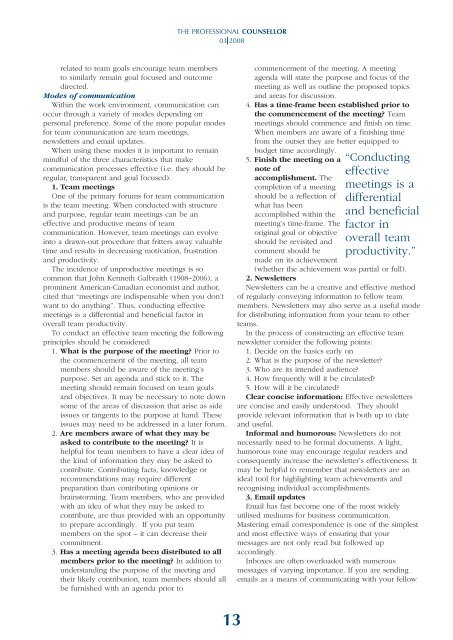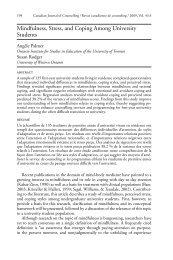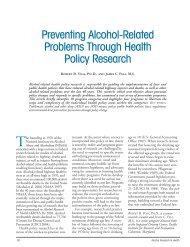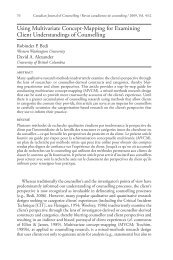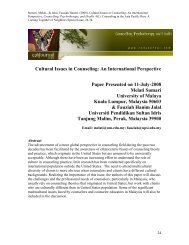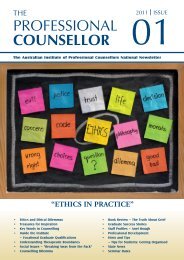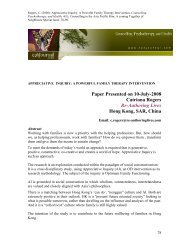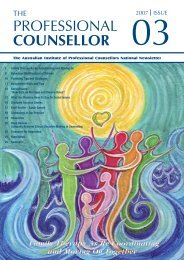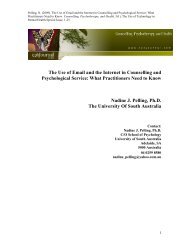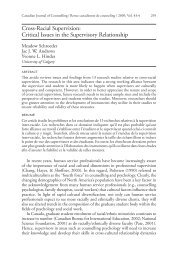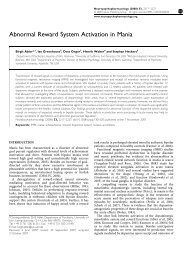PROFESSIONAL COUNSELLOR - Mental Health Academy
PROFESSIONAL COUNSELLOR - Mental Health Academy
PROFESSIONAL COUNSELLOR - Mental Health Academy
You also want an ePaper? Increase the reach of your titles
YUMPU automatically turns print PDFs into web optimized ePapers that Google loves.
THE <strong>PROFESSIONAL</strong> <strong>COUNSELLOR</strong><br />
03 2008<br />
related to team goals encourage team members<br />
to similarly remain goal focused and outcome<br />
directed.<br />
Modes of communication<br />
Within the work environment, communication can<br />
occur through a variety of modes depending on<br />
personal preference. Some of the more popular modes<br />
for team communication are team meetings,<br />
newsletters and email updates.<br />
When using these modes it is important to remain<br />
mindful of the three characteristics that make<br />
communication processes effective (i.e. they should be<br />
regular, transparent and goal focused).<br />
1. Team meetings<br />
One of the primary forums for team communication<br />
is the team meeting. When conducted with structure<br />
and purpose, regular team meetings can be an<br />
effective and productive means of team<br />
communication. However, team meetings can evolve<br />
into a drawn-out procedure that fritters away valuable<br />
time and results in decreasing motivation, frustration<br />
and productivity.<br />
The incidence of unproductive meetings is so<br />
common that John Kenneth Galbraith (1908–2006), a<br />
prominent American-Canadian economist and author,<br />
cited that “meetings are indispensable when you don’t<br />
want to do anything”. Thus, conducting effective<br />
meetings is a differential and beneficial factor in<br />
overall team productivity.<br />
To conduct an effective team meeting the following<br />
principles should be considered:<br />
1. What is the purpose of the meeting Prior to<br />
the commencement of the meeting, all team<br />
members should be aware of the meeting’s<br />
purpose. Set an agenda and stick to it. The<br />
meeting should remain focused on team goals<br />
and objectives. It may be necessary to note down<br />
some of the areas of discussion that arise as side<br />
issues or tangents to the purpose at hand. These<br />
issues may need to be addressed in a later forum.<br />
2. Are members aware of what they may be<br />
asked to contribute to the meeting It is<br />
helpful for team members to have a clear idea of<br />
the kind of information they may be asked to<br />
contribute. Contributing facts, knowledge or<br />
recommendations may require different<br />
preparation than contributing opinions or<br />
brainstorming. Team members, who are provided<br />
with an idea of what they may be asked to<br />
contribute, are thus provided with an opportunity<br />
to prepare accordingly. If you put team<br />
members on the spot – it can decrease their<br />
commitment.<br />
3. Has a meeting agenda been distributed to all<br />
members prior to the meeting In addition to<br />
understanding the purpose of the meeting and<br />
their likely contribution, team members should all<br />
be furnished with an agenda prior to<br />
commencement of the meeting. A meeting<br />
agenda will state the purpose and focus of the<br />
meeting as well as outline the proposed topics<br />
and areas for discussion.<br />
4. Has a time-frame been established prior to<br />
the commencement of the meeting Team<br />
meetings should commence and finish on time.<br />
When members are aware of a finishing time<br />
from the outset they are better equipped to<br />
budget time accordingly.<br />
5. Finish the meeting on a<br />
note of<br />
accomplishment. The<br />
completion of a meeting<br />
should be a reflection of<br />
what has been<br />
accomplished within the<br />
meeting’s time-frame. The<br />
original goal or objective<br />
should be revisited and<br />
comment should be<br />
made on its achievement<br />
“Conducting<br />
effective<br />
meetings is a<br />
differential<br />
and beneficial<br />
factor in<br />
overall team<br />
productivity.”<br />
(whether the achievement was partial or full).<br />
2. Newsletters<br />
Newsletters can be a creative and effective method<br />
of regularly conveying information to fellow team<br />
members. Newsletters may also serve as a useful mode<br />
for distributing information from your team to other<br />
teams.<br />
In the process of constructing an effective team<br />
newsletter consider the following points:<br />
1. Decide on the basics early on<br />
2. What is the purpose of the newsletter<br />
3. Who are its intended audience<br />
4. How frequently will it be circulated<br />
5. How will it be circulated<br />
Clear concise information: Effective newsletters<br />
are concise and easily understood. They should<br />
provide relevant information that is both up to date<br />
and useful.<br />
Informal and humorous: Newsletters do not<br />
necessarily need to be formal documents. A light,<br />
humorous tone may encourage regular readers and<br />
consequently increase the newsletter’s effectiveness. It<br />
may be helpful to remember that newsletters are an<br />
ideal tool for highlighting team achievements and<br />
recognising individual accomplishments.<br />
3. Email updates<br />
Email has fast become one of the most widely<br />
utilised mediums for business communication.<br />
Mastering email correspondence is one of the simplest<br />
and most effective ways of ensuring that your<br />
messages are not only read but followed up<br />
accordingly.<br />
Inboxes are often overloaded with numerous<br />
messages of varying importance. If you are sending<br />
emails as a means of communicating with your fellow<br />
13


